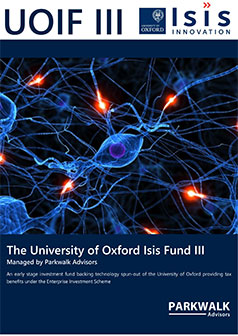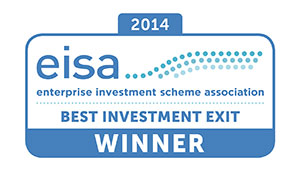|
We are delighted to have closed an investment in Oxford Endovascular, a spin-out that......
|
|
|||||
 |
|
|||||
|
Dear , The Parkwalk team would like to wish you a Happy Christmas and a healthy and prosperous 2016. The University of Oxford Isis Fund II has recently closed an investment into Oxford Endovascular Ltd, who are developing a novel treatment for brain aneurysms. A brain aneurysm is a weakened point in a blood vessel where the pulsing blood pressure causes the wall of the vessel to balloon or bulge. About one in 50 people in the UK develop aneurysms each year. If an aneurysm is left untreated it can burst or rupture, causing intense pain and life threatening bleeding into the brain which will result in serious brain damage or death. James Byrne, a Professor of Neuroradiology at the John Radcliffe Hospital and Zhong You, a Professor in the Department of Engineering Science designed the origami device after observing the limitations of existing treatments. The Technology The Oxford technology uses a special laser-cut metal alloy which has a shape-memory. It can be posted into a catheter during surgery, inserted into the brain and opened up into a tiny tube mesh (‘flow diverter’) that fits into the natural shape of the blood vessel. This diverts the blood away from the aneurysm, allowing it to heal. CEO Mike Karim said: “Cerebral aneurysms in the brain are unfortunately very common, and a third of people who develop this problem will die. A third of survivors will suffer permanent neurological damage if left untreated.” Oxford Endovascular’s chairman, Brian Howlett, said: “We believe the Oxford Endovascular device will dramatically improve outcomes for patients, as many cannot be treated with current technologies. Physicians will be able to place the device more accurately and in a wider range of patients ensuring treatment is safer and more effective. Our aim is that they will also be able to treat deeper brain blood vessels not accessible with existing devices.” The Opportunity The device was developed with support from the Wellcome Trust, Technikos and the University. Oxford Endovascular aims to complete development and begin manufacturing the device before moving into clinical trials and applying for regulatory approval in major markets. There is a strong demand from end-user interventional neuroradiologists for a new device that overcomes limitations of existing devices on market. The USPs of the Oxford Endovascular device, matched with a growing market gives excellent sales potential. Oxford Endovascular will be using the funds raised to commercialise its next generation Flow Diverter, treating areas of unmet clinical need by offering a device that has significant competitive advantages versus currently available devices. The Endovascular Cerebral Aneurysms Repair (ECAR) market is valued at $980 million and expected to grow at 5% per year, reaching $1.4 billion by 2020. The Team Brian Howlett, Chairman, has a long career as a global med-tech leader including endovascular products. He has been a board member of 5 emerging med-tech companies and CEO of Lombard Medical (2005-09) and the UK General Manager of Boston Scientific (1999-2005). Mike Karim, CEO, has over 20 years’ experience in medical devices including endovascular products. He has held leadership roles in sales, marketing and general management including Boston Scientific and Lombard Medical. James Byrne, Clinical Director, has over 30 years’ first-hand clinical experience treating aneurysm patients including clinical trial experience for novel devices. James has published >100 scientific papers and run >30 course training MDs to treat aneurysms. He is the inventor of the Oxiflow flow-diverter. The Investment Case The company will use the funding for development, to complete a final round of animal studies before conducting first-in-man clinical trial on around 30 patients and to achieve CE mark approval from European regulators. The Company’s addressable markets are significant, and Oxford Endovascular has long term investors with the capacity to fund them through to achieve their potential. |
||
|
|||||
|
|||||
|
||
|
|||||


